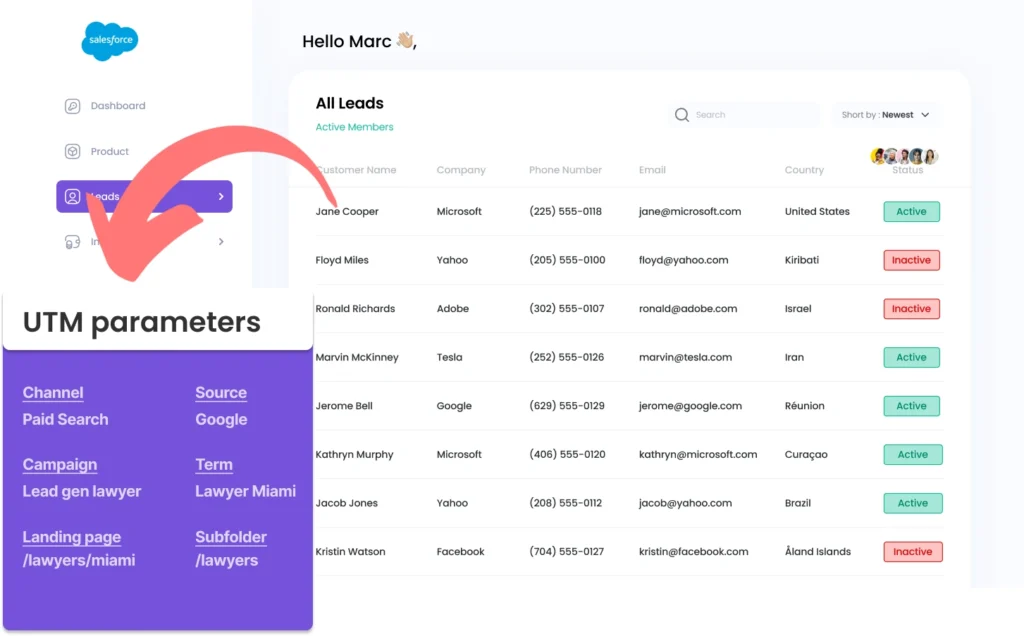Why tracking UTM parameters in your CRM?
🔗 UTM parameters are added to URLs to track the marketing performance across different traffic sources. These parameters include utm_source, utm_medium, utm_campaign, utm_term, and utm_content, each providing specific data about how visitors arrived at your website.

As leads arrive at your CRM from different lead sources, UTM parameters allow you to identify the channels, sources, campaigns, ads, etc. your leads are coming from.
For every lead that transforms into a paid customer, you can track where these exact customers came from (channel, source, ad, etc.).
👉 The benefits of tracking UTM parameters in your CRM are multiple:
- Optimize your marketing budget: when you know which channel, campaign, or ad your leads are coming from, you can adapt your marketing campaigns accordingly to those that bring the most leads
- Calculate your ROI: when you track UTM parameters in your CRM, you can know where your sales are coming from. You know exactly which ad generated the sale, and how much revenue the sale was. You can then accurately calculate your return on investment (ROI).
- Make data-driven decisions: When you know that an ad generates a large volume of leads, but these leads don’t convert as paid customers, you can make confident decisions on which ads to spend your marketing budget, and which ads to pause.
- Personalize your sales pitch: When a new lead pops into your CRM, and UTM parameters tell you where it comes from (emailing, ad, etc.), you can adapt your communication accordingly and provide a more custom approach to your sales pitch.
2 methods to track UTM parameters in your CRM
Google Tag Manager
To pass the UTM parameters from the URL to your CRM, using GTM (Google Tag Manager), we have to go through the following steps:
- Store UTM Parameters: Use GTM to capture UTM parameters from the URL and store them in a first-party cookie.
- Create GTM Variables: Set up variables in GTM to retrieve these stored UTM values.
- Populate Form Fields: Use these variables to auto-fill hidden fields in your website’s lead capture form.
- Send Data to CRM: Upon form submission, the UTM data is sent to the CRM along with the form details.
This method is free, but requires some coding.
Below is another method that is fast to implement and doesn’t require any coding skills 👇
Using Leadsources to track the UTM parameters in your CRM
Leasource is a UTM tracking tool that captures the UTM parameters from your URL, insert them to your form, and send them to your CRM upon submission of the form.
To start tracking your UTM parameters in your CRM, add the Leadsources tracking code in the head tag of your website. And you are ready to go🚀
Leadsources will automatically grab the value from your UTM parameters, and store them into your form (in the hidden fields). When the form is submitted, the UTM parameters are sent, alongside the leads details (email,, etc.), in your CRM.

Not using UTM parameters? No worries. Leadsources also captures the lead source data stored in your cookie for a comprehensive lead source tracking.
And, Leadsources is not limited to track the source of your leads, it captures 7 data points to create a precise picture of your leads’ source:
- Channel
- Source
- Campaign
- Term
- Content
- Landing page
- Landing page subfolder
👉Benefits of using Leadsources to capture your UTM parameters in your CRM:
- Intelligent channel categorization: Leadsources assigns a channel to each lead (Organic Search, Paid Social, Email, etc.), depending on the source of your lead. This allows you to get a clean categorization of your channel. That’s particularly useful when you have misspells or reduddancies in your UTM parameters (E.G. googlz, google, google.com, googlecom –> The channel attributed to all these channels by Leadsources is: “Organic Search”)
- Easy installation / Easy to use: Simply add the Leadsources tracking tag in the head tag of your website to start tracking your UTM parameters.
- Compatible with 100+ apps: Leadsources is compatible with most form builders, allowing you to track your UTM parameters from all your web pages, and forms. No need to add a custom code for each landing page and each form.
Once the UTM parameters are stored in your CRM on a lead-level, you can run powerful lead source reports such as:
Leads, sales or revenue reports by… channel, source, campaign, content, term, landing page, and landing page subfolder.
🎯Start tracking the UTM parameters in your CRM using our detailed guides:
- ACT CRM
- Activecampaign CRM
- Agile CRM
- Apptivo CRM
- Capsule CRM
- ClickUp CRM
- Close CRM
- Copper CRM
- Creatio CRM
- Freshsales CRM
- HubSpot CRM
- Insightly
- Keap
- Kylas Sales CRM
- Leadsquared
- Microsoft Dynamics CRM
- Monday Sales CRM
- NetSuite CRM
- Nimble CRM
- Nutshell CRM
- Perfex
- Pipedrive
- Sage CRM
- Salesforce
- SAP
- Sugar CRM
- Thryv CRM
- Trello
- Zendesk Sell
- Zoho CRM
👉Finally, check out our other guides:

